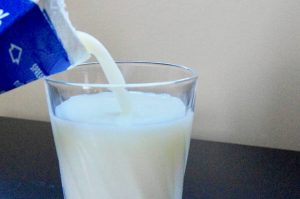
A million people were estimated to have watched his riveting video message within a couple of days after it was posted on TikTok and spread to other social media platforms.
“At the end of the month, I have to dump all my milk. (I’m) supposed to keep it quiet,” Huigen says in the footage, staring intently into the camera as he wags his finger.
The original video has since been deleted by the family but lives on through multiple online copies that continue to be shared. The mainstream media also latched onto Huigen’s message, which went ‘viral’ in the same week that the Canadian Dairy Commission imposed a Feb. 1 dairy price hike.
Dairy farmers are told “just throw it down the drain, nobody sees it, it’s OK,” Huigen says in the video, after taking a swig from the raw milk stream that spills onto the concrete while his cows are milked in the background. “Well, it’s not OK.”
The farmer is paid about 90 cents per litre for the milk he doesn’t dump. Huigen dramatically places a bottle of the premium Fairlife brand beside the outflow of wasted milk to draw a contrast. “How do you guys dare to put this product on the market for $7 a litre, and think that’s OK?” he declares. He suggests the wasted milk should go to single mothers or hospitals instead.
No other country compels its farmers to dump milk down the drain, he adds.
Filling quota has been likened to filling a bucket to its absolute maximum. The only way to totally hit 100 % of capacity is to slightly overfill and let the excess run off. By default, this creates waste unless there’s a conscious effort to deal with the overflow. But dairy farmers contacted by Farmers Forum said the system does accommodate some overproduction, so long as the farmer practices good management. If he overproduces one month, the excess is credited toward a subsequent month when he underproduces.
Huigen has since received a lot of criticism from other dairy farmers on social media.
In short, Huigen wouldn’t be dumping milk unless he had already exhausted his allowable over-quota float equivalent to 10-days worth of production, wrote Cornwall-area producer and columnist Angela Dorie. A herd of 260 cows would produce 30,000 litres in about four days.
“He missed the ball by that much, but he has the right to say what he wants,” Meaford-area producer Paul Vickers observed.
“He knows the rules of the quota system, it’s quite simple,” said Cornwall-area producer Doug Robinson. “Either you dry cows up or you sell your (extra) cows. Everybody is in the same boat. That’s just poor management.”
Irma Brink of Grand Valley echoed Robinson’s advice, observing: “If you produce 30,000 litres too much, then you have a problem.”
Brink, who chose to be part of Canada’s dairy quota system when she and her husband left their native Holland in 2017, said that if Huigen doesn’t like the system, he can set up in the U.S. The downside there is that milk prices fluctuate and often dips too low to make a happy farmer, she noted.
Professor Sylvain Charlebois, director of the Agri-Food Analytics Lab at Dalhousie University, estimated that between 100 and 300 million litres of milk is discarded annually in Canada as farmers meet their production quotas. It’s “dairy’s dirty secret for years” and happens “quite frequently,” he said.
“The first step is to make milk-dumping illegal,” Charlebois advised, laying the blame on the marketing boards, such as DFO, for the current practice, not individual producers. “If you make it illegal, then you’re going to force change.”
Charlebois added that the Canadian Dairy Commission could arrange for the dehydration, storage and ultimate export of the surplus milk. The CDC already operates a national strategic butter reserve. Just extend the organization’s scope to handle the orphaned milk, in powdered form. “That’s all you need to do,” he said.
The powdered milk could be exported to overseas buyers, he assured, just as surely as Kingston’s Fehe plant turns Ontario milk into baby formula that is exported to China.
Huigen did “the right thing” by going public in the way that he did, Charlebois said. “Obviously, this farmer felt it was very important to convey this to Canadians who are dealing with a very high food inflation rate.”
He claimed that the “mismanagement” accusation being levelled at Huigen is typical treatment for those exposing shortcomings in the system. “The DFO is individualizing the issue and targeting this one guy and making him look stupid. That’s what they do,” he said.
Milk dumping doesn’t fit with supply management’s image as a more efficient, less wasteful system, nor does it accord with the federal government’s more recent “sustainability” objectives, the professor warned. “Why would you ever want to produce food for nothing?”
Ontario dairy farmers do have the option of allotting a planned amount of their monthly production into DFO’s long-standing food bank program. But that program doesn’t accommodate unplanned large donations on a moment’s notice.
Watch the video below.

























